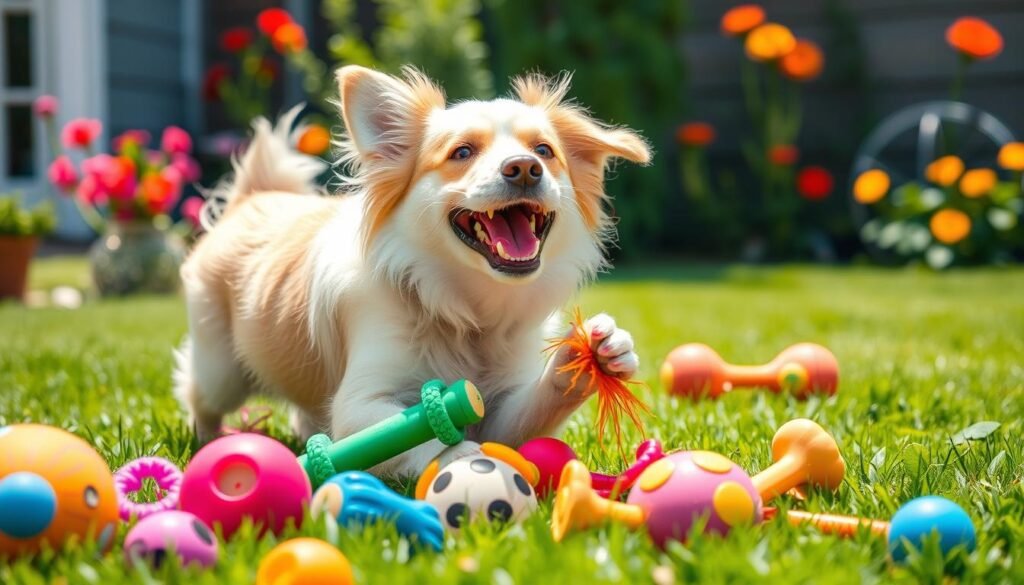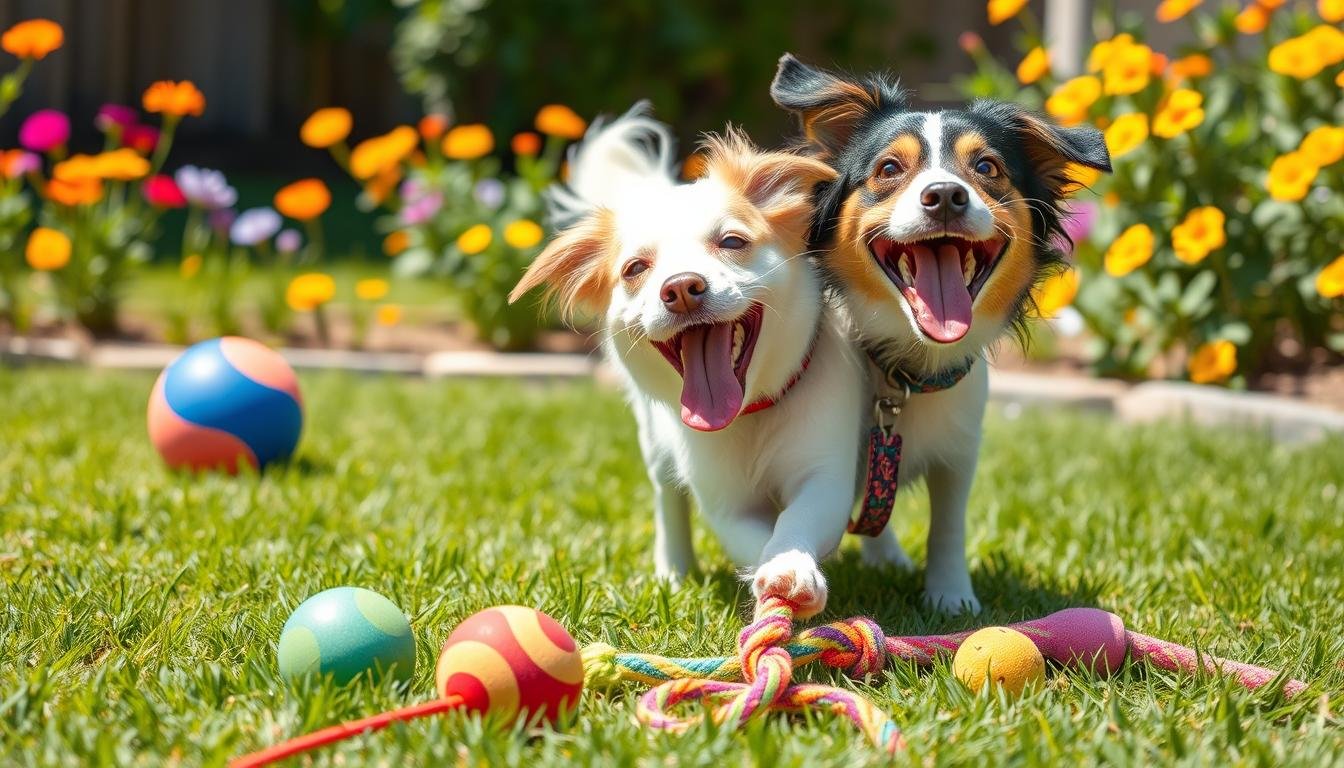Many of us have seen our dogs ignore new toys. It’s a common issue, with studies showing many dogs don’t want to play with toys at first1. But, with the right steps and patience, we can make our dogs love playing.
Our goal is to give our dogs a happy and full life. Playing with toys helps them release energy and keeps their minds sharp. It also makes our bond stronger. By focusing on mental stimulation and positive reinforcement, we can bring joy and engagement into their lives.
Key Takeaways
- Getting a dog to play with toys can be tough at first, but patience and positive reinforcement help.
- Playing with dogs not only burns off energy but also keeps their minds active, strengthening our bond.
- Using a variety of durable toys, changing them often, and playing to their preferences keeps dogs interested.
- Always check the safety of new toys, watching for choking hazards and supervising closely.
- Being consistent, creative, and understanding your dog’s personality and needs is key to a lifelong love of play.
Understanding the Importance of Play
Play is key for a dog’s happiness, offering mental fun, energy release, and a stronger bond with their owner2. Dogs play to use up energy and learn social skills and emotional bonds3. Play is essential for a dog’s happiness, no matter their age3.
Mental Stimulation and Energy Release
Dogs love to play, with most showing a strong interest in toys4. Playtime gives them the mental and physical rest they need, helping them release energy in a good way4. Some dogs even prefer playing with toys over eating treats, finding it more fun2.
Bonding and Positive Reinforcement
Play is also a great way to strengthen the bond between a dog and its owner2. Using play as a reward during training makes learning fun and rewarding for dogs2. It also boosts their confidence and trust, improving their and their owner’s life quality2.
The role of play in a dog’s life is huge. It’s vital for their mental and physical health, and for their bond with humans3. By making play a regular part of a dog’s day, owners can keep them happy, healthy, and well-rounded2.
How to Get Your Dog to Play with Toys
Getting your dog to play with toys is fun for both of you. Introducing new toys and sparking their interest is the first step5.
Start by slowly introducing toys and letting your dog get used to them. Praise and treats help them learn to enjoy playing5. Try using food-stuffed toys or peanut butter to make them curious5.
- Use training cues like “take it” or “bring it” to improve obedience and keep them engaged in play.
- Change the toys often to keep your dog excited and curious. A variety of toys helps prevent boredom and keeps them rewarding interest in play5.
- Always watch your dog when introducing new toys to keep them safe and avoid choking hazards5.
- If your dog acts out, like nipping, leave the toy and step away to avoid negative reinforcement5.
Be patient and use positive reinforcement when introducing toys and playing. With time and consistency, your dog will enjoy playing with toys56.
| Toy Type | Price Range |
|---|---|
| Durable Chew Toys | $2.00 – $15.98 |
| Interactive Puzzle Toys | $10.00 – $25.98 |
| Plush Squeaky Toys | $5.00 – $12.98 |
| Fetch and Tug Toys | $8.00 – $18.98 |
| Automatic Ball Launchers | $30.00 – $45.98 |
By using these strategies, you can introduce toys, reward their interest, and help your dog enjoy playing. Remember, patience and consistency are key to making your dog happy and fulfilled56.

“Engaging your dog in regular playtime with toys helps to meet their physical and mental needs, leading to a happier, healthier, and more well-adjusted companion.”
Conclusion
Encouraging your dog to play with toys is key for their happiness and growth. We’ve shared ways to keep them mentally active and bond with them. Choosing the right toys can make playtime more fun and fulfilling for them7.
Not all dogs love toys right away. But with time, patience, and the right training, they can learn to enjoy them. Using treats in toys and showing excitement when introducing new ones can help7. Knowing your dog’s likes and needs, and teaching them to play gently, also matters8.
The journey of teaching your dog to love toys is rewarding. It needs patience, creativity, and understanding. By focusing on their mental health, bonding, and offering fun toys, we can make their lives better. With these tips, you can create a lifelong bond through play and toys78.
FAQ
Why is it important for dogs to play with toys?
What are some common reasons why dogs may not be inclined to play with toys?
How can we encourage our dogs to play with toys?
Source Links
- How to Teach Your Dog to Play with Toys – https://jollypets.com/blogs/your-pets-happiness-and-health/how-to-teach-your-dog-to-play-with-toys?srsltid=AfmBOop8oHkHXzMGs4bFqP5XM2Wcu-_0k6ecjXf-Z_GCjfz0aoWIIt1Z
- Creating Reward Events- Using Play with Food & Toy Rewards in Training – De Marinis Dog Training & Behavior – https://demarinisdogtraining.com/toy-rewards-play/
- Let the Good Times Roll: The Healthy Benefits of Dogs Playing and How to Make it Happen – Snouts and Stouts – https://snoutsnstouts.com/dog-behavior/dogs-playing/
- Owner’s Guide to The Psychology Of Dogs and Their Dog Toys – https://holidaybarn.com/blog/psychology-of-dogs-and-toys/
- How to Teach Your Dog to Play with Toys – https://jollypets.com/blogs/your-pets-happiness-and-health/how-to-teach-your-dog-to-play-with-toys?srsltid=AfmBOorPuCVW9p_FwBkBBEBQkuNFR6Z4jrDxzQHZN3SBmaobpRb0WxOx
- My Rescue Dog Doesn’t Play With Toys, So I Brought In an Expert to Help – https://www.popsugar.com/pets/why-wont-my-rescue-dog-play-with-toys-47503703
- How to Make Your Dog Love Their New Toy: 5 Great Ways – Dogster – https://www.dogster.com/lifestyle/how-to-make-dog-love-new-toy
- Nutram Pet Products :: article – https://nutram.com/article/top_7_tips_for_teaching_dogs_gentle_play

